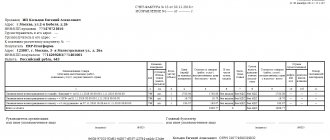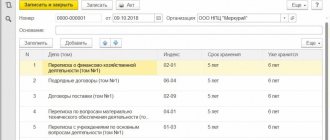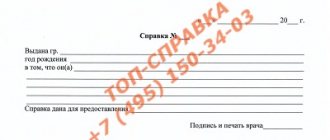Documents and documentation systems
System of organizational and legal documentation
The concept of organization underlies all management activities. This function is certainly primary in relation to other management functions, since you first need to organize the system, and then plan its activities, regulate and control it. As part of the organizational function, subfunctions are distinguished, for example, creating an organization, establishing a structure and staffing levels, distributing responsibilities between management, regulating the activities of departments and employees, establishing a remuneration system, operating hours, etc. The content of the organizational function determines the purpose of organizational and legal documents - to regulate the activities organization in all its aspects.
Organizational and legal documents include:
the organization's charter (or regulations on the organization), staffing table, regulations on structural divisions, collegial and advisory bodies, work regulations, rules, regulations, instructions regulating certain areas of the organization's activities, job descriptions.
The most diverse and least regulated group are rules, regulations, and instructions. These documents can be developed for any area of the organization’s activities (internal labor regulations, regulations on remuneration, regulations on the protection of personal data of employees, instructions for documentation support).
The system of organizational and legal documentation is represented by a large number of types of documents, for example:
| Document type | Types of document |
| Instructions | Instructions for documentation support of management |
| User's instructions for the DBA "Office", etc. | |
| Job description | Job description of a specialist of the 2nd category |
| Cashier job description, etc. | |
| Position | Regulations on the department |
| Regulations on the Board of Directors, etc. | |
| Regulations | Rules of the Collegium |
| Management regulations, etc. |
Planning documentation system
The general purpose of planning documentation is to establish the goals and objectives of the organization, determine the necessary resources and distribute them according to goals and objectives. Planning documents are programs, plans, schedules.
The activities of the organization as a whole, individual areas of activity and divisions can be planned.
Planning documents can have different frequency: year, six months, quarter, month. As a rule, planning documents that establish general indicators for the organization as a whole and for certain areas of activity are approved by the head of the organization or a collegial body (council, meeting, etc.). Plans prepared on their basis, for example work plans for departments, do not require approval.
The planning documentation system is also represented by a large number of types of documents:
| Document type | Types of document |
| Plan | Action plan to implement the resolution... |
| Plan for the socio-economic development of the organization’s staff | |
| Board of Directors work plan | |
| Business plan | |
| Department work plan | |
| Individual work plan, etc. |
System of administrative documentation
The system of administrative documents is designed to regulate the activities of the organization. Regulation of activities is necessary to fulfill assigned tasks (programs, plans). Regulatory activities are necessary to eliminate emerging interference and deviations from the parameters specified by planning documents. The main task of regulation is to ensure consistency in the activities of the divisions and officials of the organization.
Decisions made in the regulatory process are recorded in documents that make up the administrative documentation system. These are the following types of documents: resolutions, decisions, orders, instructions, instructions.
Administrative documents are also represented by a large number of types of documents:
| Document type | Types of document |
| Order | Order on the distribution of responsibilities between management |
| Order on the creation of a branch (branch, representative office) | |
| Order of approval (regulations, rules, instructions) | |
| Order on financing the work... | |
| The order of acceptance to work | |
| Order on business trip, etc. |
Reporting documentation system
The documents included in the reporting documentation system are documents with the help of which the management function of monitoring activities is implemented. Control as a management function consists of quantitative and qualitative assessment of the organization's performance results. It is control that allows the subject of management to compare the results obtained with the indicators determined by the plan or program. Control activities allow you to establish a kind of feedback in the management system, which allows you to correct previously made decisions and use control results in planning.
The reporting documentation system is represented by such types of documents as a report, a certificate (of a reporting nature).
Accounting reports are usually called balance sheets. Despite such poverty in terms of species, the reporting documentation system is very complex in composition - it includes at least three independent classes of systems: the state statistical reporting system, departmental reporting systems and intra-institutional reporting. Thus, the reporting documentation system is represented by a large number of types of documents:
| Document type | Types of document |
| Report | Research report |
| Business trip report | |
| Report on the work of the structural unit | |
| Report on the advertising campaign, etc. |
Information and reference documentation system
Managerial functions are implemented in the activities of the institution through the decision-making process. The management documentation systems considered include only those documents that record management decisions: the organizational documentation system includes documents containing decisions of an organizational type, the planning documentation system consists of documents containing planning decisions, etc. The decision-making process in its most general form is a transformation of some initial information. There are two main stages in this process: information preparation of a decision (the “pre-decision” stage), consisting of collecting information, analyzing it, classifying it, summarizing it, searching for alternatives, and making the decision itself. Information about the state of affairs in the management system and the need to make decisions of one type or another is received by the governing body in the form of documents of a special type, different from those discussed above. These are documents that in management practice are usually called reference, information and reference, analytical or information and analytical.
The general purpose of these documents is to deliver information to the governing body about the actual state of affairs in the system, about failures in the system, and about situations that need to be corrected through decision-making. Information about the state of affairs in the system can come from various sources: from departments, individual employees, subordinate and third-party organizations, from commissions specially created for various purposes and other sources. Hence the wide variety of types of these documents: reports, official, analytical notes, official letters, certificates (informational and analytical), reports, acts, protocols, etc.
The peculiarity of information and reference documents is that they serve all management functions; any decision is based on them, no matter what issue of the organization’s activities it is made. Strictly speaking, this set of documents should be included as an integral part in each of the documentation systems considered, but since the general purpose of these documents is the same (regardless of the implementation of which management function they are created), it is more appropriate, in our opinion, to highlight them into a separate documentation system.
Each type of information and reference documents is represented by many varieties, for example:
| Document type | Types of document |
| Act | Audit report |
| Report of inspection of financial and economic activities | |
| Act of acceptance and transfer of cases | |
| Examination report, etc. | |
| Letter | Letter (reminder) about the approaching deadlines for the execution of the contract |
| Letter (claim) about violation of the terms of the contract | |
| Letter (offer) for the provision of services (delivery of goods) | |
| Letter (invitation) about participation in the exhibition, etc. |
Contract documentation system
In the process of carrying out its activities, any organization enters into relationships with other organizations and individuals. These relationships are necessary, first of all, to achieve the goals and objectives of the organization. Its relationships with external contractors (organizations, individuals) are carried out through contracts. Agreements can be concluded in any area of the organization’s activities. The decision to conclude an agreement is made by the manager (the agreement is also signed by the manager or an official authorized by him). Documents of contractual type are called treaties, contracts, agreements.
The use of a particular name in a specific situation is fixed by regulatory documents or traditions established in management activities. The legislation distinguishes two main types of contracts: civil contracts and contracts in the field of labor relations. Civil contracts are the richest in terms of species.
| Document type | Types of document |
| Agreement | Contract of sale |
| Supply contract | |
| Lease agreement (sublease agreement) | |
| Contract agreement (subcontract agreement) | |
| Commission agreement | |
| Contract of carriage, etc. |
Supporting documentation systems
The documentation systems considered can be classified as systems that implement basic management functions, but in the activities of any organization, documents are formed that reflect the main (production) activities of the organization (trade, educational, medical, editorial, publishing, research, etc.).
The composition of these documents is determined by the content of the organization's main activities. For example, in a higher educational institution, the main activities are reflected in the documentation system for higher education - this is a document system that is significant in volume and diverse in type. For the most part, documents reflecting the educational process at a university are accounting documents. The most typical example of this kind of documents are progress records (tests, exams), lists, exam papers, etc.
A feature of supporting type documentation systems is that the bulk of the documents that make up these systems are accounting documents
, that is, documents that implement the accounting function, which is reflected in the names of these documents: statement, sheet, sheet, time sheet, map, card, book, journal (accounting), etc.
Articles of association
The charter of an organization is a legal act that contains a list of rules that have been established by the state or an enterprise (organization) that has the authority to regulate and manage the activities of such organizations. The charter can be disciplinary, drill, veterinary, LLC Charter, JSC Charter and others. Such a document is approved by the founders and the legal status of the organization as a legal entity is established. Being a legal entity, you can already undergo state registration.
Regulations on the organization
The regulation on the organization is another legal act. Budgetary state organizations, government bodies, as well as branches and branches of organizations of various forms of ownership operate on the basis of the provisions. The regulations outline the rights, functions, tasks, procedures and degree of responsibility of the organization.
The regulations of a non-profit organization state:
- full name of the organization indicating the type of activity
- organizational and legal form of organization
- the type of activity and its goals are determined
- activity management
- legal address of the organization
- rights and obligations of its members
- information about branches and representative offices
- terms and membership, if any
- sources of property formation
- procedure for using common property in the event of liquidation, if the organization is non-profit
- procedure for changing constituent documents for non-profit organizations.
All provisions are spelled out in the Federal Law “On Non-Profit Organizations” dated January 12, 1996 No. 7-FZ. To draw up the Regulations on the organization, a general form of the organization has been developed.
Using Docsvision to manage external documentation
As GOSTs state, the degree of documentation of a company must comply with legislative, contractual and other mandatory requirements. To do this, it is necessary to develop management procedures for checking papers for adequacy, identification, updating, recording and storage. It is most convenient to do this within the framework of a unified document management system organized in electronic form. This is the only way to achieve speed, transparency and quality of management.
Managing external documentation on the solution platform is a streamlined, well-controlled process. Docsvision software products allow you to solve all related problems at a high level. With the help of EDMS, customers will be able to quickly and efficiently:
- receive all external documentation and include it in the general internal circulation;
- regularly update, check for relevance and approve documentation before accepting it for execution;
- set up a system for indicating changes and editions of external documents;
- ensure clear identification and ordering of groups of incoming documents;
- timely transfer outdated papers to a well-organized archive;
- monitor compliance with the requirements of external documents by employees.
The procedure for registering normative documents
The procedure for registering legal acts entering the organization is carried out in accordance with existing instructions. Currently, there are industry orders, according to which standards are recorded in accordance with the specifics of a particular enterprise.
To resolve the issue in a general manner, you should use the current provisions of the methodological recommendations of GOST R 6.30-97 “Unified documentation systems. Unified system of organizational and administrative documentation." Registration of regulatory documents at enterprises is carried out in several stages:
| Regulatory document registration stage | Explanations |
| The document is checked for “normativity” | By default, any document received by an organization cannot be recognized as normative. For this reason, a preliminary examination is carried out in relation to such an act to determine whether its contents comply with terminology, technical standards and other parameters. After this, the document is assigned the appropriate status or stamp. |
| The completeness of the document is determined | Document contents:
|
| The correctness of the design is assessed | The compliance of the regulatory document subject to registration with the registration rules is checked. |
| Sets the validity period of the document | Particular attention in decrees and norms is paid to their validity period. If recommendations are temporary, this is reflected in the document card. Upon reaching the set time, the document loses its relevance, which must either be communicated to the relevant executors, or replaced with a newly issued regulation. |
The basic requirements for accounting for regulatory documents are set out in the accounting policy of the enterprise. Usually it specifies where, how and by whom journals of registration of regulatory documents are published and maintained.
List of documents for foreign citizens
The form of the employment contract depends on the status of the foreign worker. There are three forms:
- those who are in the country temporarily for work;
- those who reside in the country temporarily;
- those who permanently reside in the country;
The easiest way to hire a person who resides in the country permanently. The only difference between accepting them and an ordinary citizen of the Russian Federation is the request for a residence permit, which is usually issued for 5 years, but can subsequently be extended.
Also, these subjects can work without a work permit, but must find work in the region where they have a residence permit. Otherwise, they have no legal basis for work.
Create a folder shortcut to your desktop
Open Windows Explorer or Computer browser and locate the folder on your computer's hard drive.
For those who have forgotten: Explorer can be opened by right-clicking on the Start button and selecting “Open Explorer” in the context menu, or by left-clicking on the Explorer icon in the taskbar on the left.
Right-click on the desired folder to open the context menu, where select “ Create shortcut ”.
As a result of this operation, a shortcut “name of the selected folder-Shortcut” will appear,
which, by clicking with the left mouse button (LMB on the shortcut and not releasing), you need to drag it to the desktop.
By double-clicking on the created shortcut on the computer desktop, the user gets quick access to the desired folder.
The only thing is that if you move the target folder to another location on your hard drive, its shortcut will stop working, because it contains information about the specific folder location that has changed. The system will display a corresponding message.
In this case, you need to delete the old shortcut and re-create a new one in the same way as described above.
Share.
More on the topic:
- Organizing Data in Windows Good organization of data involves organizing files by storing them in separate folders. Windows organizes files and folders in a specific way. With the help in advance […]
- What is a clipboard? Almost all computer dummies, when faced with the concept of “clipboard,” have difficulty understanding what it is and what its use is. Heard from more advanced users such [...]
- How to select files and folders Selecting files and folders in the operating system is one of the most common operations. The need for this operation arises when copying, moving, archiving, deleting [...]
- Access recently opened files and folders If you want to find a file, open it, and continue working on a file that you recently opened, use the Quick Access feature provided by Windows. Open the Start button menu and […]
- Archiving files using Windows To reduce the size of a file or all files in a folder, you can compress them or, in another way, archive them. Typically this technique is used in cases where files are sent via […]
How is the recording of regulatory documents organized in the laboratory?
The standard for working with governing documents in the field of the testing complex is largely based on the document management system. The quality of the organization of document flow allows us to judge not only the mandatory compliance with the requirements of regulatory documents, but also the presence of a current accounting methodology, which includes:
- Rules according to which incoming documentation is approved and subsequently accepted for accounting in the laboratory;
- Regulations for familiarizing staff members with the contents of governing acts;
- Rules that prescribe the procedure for handling regulatory documents. This applies to creating backup copies, storing them in files with the possibility of subsequent restoration;
- The current procedure for updating documents regulating the activities of full-time laboratory technicians (trainees and interns), according to which all incoming acts are compared with existing ones. Based on the results of the reconciliation, the legal framework is brought up to date. If necessary, appropriate changes are made to previously recorded documents;
- A system according to which the storage, including archival, of regulatory documentation is organized in the office work of the testing complex. The set of measures includes instructions developed and communicated to employees;
- All documents stored in the laboratory must be divided into the following categories:
- Legal acts;
- Internal administrative documents;
- External instructions that were developed outside the laboratories, for example, higher-level special regulations;
- Direction standards;
- Technical documentation;
- Reference materials.
Currently, specialized programs, for example, ASDOU, show sufficient efficiency in organizing the document flow of regulatory acts. Having such applications at your disposal, you can set up an accounting system with a division of responsibilities between responsible persons in a short time.










